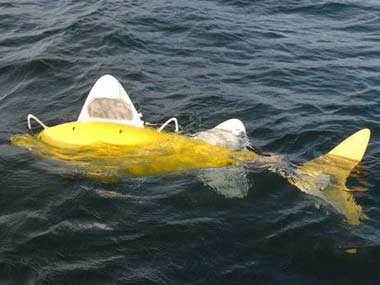 If you’re heading to Northern Spain this summer, port Gijon in particular; do not be frightened if a yellowish fish sprints beside you.
If you’re heading to Northern Spain this summer, port Gijon in particular; do not be frightened if a yellowish fish sprints beside you.
Apparently scientists from all over the globe, in a bid to combat pollution, are experimenting and eager to update the marine watch with a revolutionary robo-fish, composed solely from fiber and metal.
A number of these are actually undergoing rigorous tests to find out if they are compatible to become the new aquatic police.
“The idea is that we want to have real-time monitoring of pollution, so that if someone is dumping chemicals or something is leaking, we can get to it straight away, find out what is causing the problem and put a stop to it,” explains Luke Speller, a senior scientist at the research division of BMT Group, a technology consultancy.
The idea is speeding up the shore monitoring process from months to seconds; since at the moment, samples are being taken once a month, according to Dr Speller.
This could eliminate the chances of a ship leaking chemicals into the coastline and getting away with it.
The fish, which are 1.5 meters (5 feet) long and currently cost 20,000 pounds ( $31,500) each, are designed to swim like real fish and are fitted with sensors to pick up pollutants leaking from ships or undersea pipelines.
So what’s so special about this fish?
1. A minute chemical sensor is one of the key features that lives inside the fish. Water is allowed to pass through the body of the fish and could pass over the chemical sensor allowing scientists to detect pollutants in the water such as lead, copper etc.
2. The fish can also “see” under water using a sonar; this allows the fish to perform obstacle avoidance and range viding under water so it knows where it is and can stay safe and return to base when its battery life runs low.
3. Deep inside the core of the fish lives a small computer than runs the artificial intelligence of the fish allowing it to figure out where to go and the best ways to monitor pollution.
4. The fish can work either autonomously, or co-ordinate with each other through acoustic signals, to transmit their readings back to shore station, that could be up to a kilometer away.
5. Another key feature of the fish is its propulsion ; it doesn’t use a propeller like standard underwater robotics, but has a tail, which allows it to look and move like a fish under water ; this is quieter, more efficient and also allows for better maneuvering.
After the tests this week, the team will look at modifications needed to move the fish into commercial production, which they expect to reduce the cost of each unit and hopefully prolong the current eight hour battery life.
![]()

Looking for a simple, elegant backup solution?
Genie Timeline 2012 is a new version of the number one continuous data protection program Timeline 2.1. It offers the first metro style user interface; enhanced performance, and added features. Like us on Facebook and Follow us on Twitter for the latest news.
>Follow @Genie9backup
![]()

